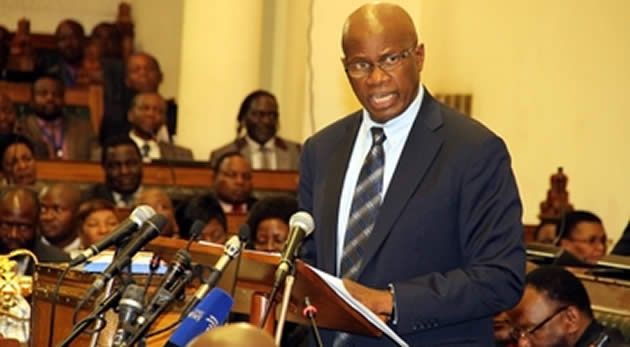High expectations from budget

Linda Tsarwe Business Correspondent
The much awaited 2014 budget was presented by the Minister of Finance last week Thursday. It came at a time when the economy is facing a myriad of challenges. Currently the country is in a severe liquidity crunch, which is threatening the collapse of the financial sector.
The manufacturing sector is operating at around 39,6 percent capacity while at the same time energy generation levels are too low to meet demand.
These, among other issues, were noted as the key economic challenges, which required immediate resolve if the economy is to move forward.
Retrospectively, the budget highlighted a discouraging 2013 economic performance. Revenue to November 2013 was below target at US$3,86 billion.
Tax revenue was lower than target owing to sluggish economic activity. Recurrent expenditure continued to dominate regardless of declining revenues, with employment costs taking up 68,9 percent of the total expenditure bill.
As a result, only US$392 million was left for capital expenditure, which is paltry relative to the need for it. The current account deficit continued to widen at US$3,8 billion as exports declined by 12,5 percent to US$2,8 billion from 2012 levels.
Imports were, however, on the increase at US$6,6 billion by October 2013, from US$6,1 billion in October 2012. Furthermore, the country’s external debt stood at US$6,077 billion as at December 31 2012, representing 49 percent of GDP.
Inflation, on the other hand, has been on the decline, opening at 2,5 percent this year, and declining to 0,54 percent in November 2013.
This is bringing fears of a possible deflation, which is detrimental to economic growth.
Clearly, the economy is in intensive care and it was the hope of everyone that the budget addresses the pressing issues to rescue the economy in the coming year.
For 2014, revenue is expected to improve to US$4,12 billion supported by a slight improvement in tax revenue.
However, employment costs are likely to continue putting pressure on income and capital expenditure will remain low. It is clear that the strain of the wage bill requires attention.
Government is targeting the bill to come down from its current level of 73 percent of the total budget to the ranges of between 55 percent and 65 percent by 2015.
While this is a move in the right direction, it however poses the question of how this will be achieved. Civil service salaries have remained modest and below the Poverty Datum Line. There is continuous pressure from their workers unions to increase their salaries to at least up to PDL level which has been reported to be around US$600 per month.
Hence to achieve their wage bill target, it will only be possible through an increase in revenue.
This points to a possibility of an aggressive tax system. Already, the fiscal policy has increased the tax rate for those earning above US$20,000 to a flat rate of 50 percent.
Although this has been tabled as a measure to reduce the gap of high income earners with those at the bottom of the income ladder, it is also a strategic step to earn more tax revenue.
Critics of an aggressive tax regime point out that it does not work, contrary to the general belief. This is however, debatable and others believe broadening tax revenue sources is more effective. As a new revenue earning avenue, Government has introduced tax on mobile money transactions of US$0,05 per transaction.
However, this is likely to be controversial, on social grounds of course. Such charges are always sensitive mainly because on average, the bulk of the workforce is earning relatively low income.
Ideally, in a well functioning economy, tax revenue will be much higher and might result in products targeted for low income earners to be exempt from tax.
Corporate income tax, which should be one of the major contributors of revenue under normal economic environment, can only start to contribute meaningfully to the country’s revenues if industries are resuscitated.
Liquidity crunch has only worsened the economic crisis, with the financial sector currently hanging by the thread. Administrative issues such as delays in RTGS payments and cash shortages are some of the manifestations of how bad the liquidity crisis is.
To improve the dire situation, US$100 million facility will be availed to the banking sector for interbank trading purposes, supported by an international bank and guaranteed by Afrexim with effect from 1 April 2014.
The funds are expected to provide relief to the liquidity drought in the banking sector. Furthermore, another measure is to capacitate the RBZ as a lender of last resort.
The Government will initially assume all of the central bank’s debt of US$1,35 billion.
Following the clean-up of the balance sheet, funds to the tune of between US$150million and US$200 million will be injected as capital into the bank by 31 March 2014, to capacitate it to perform the function of being a lender of last resort.
Both steps are well intentioned and in the right direction. If such funding does come through, it will work in resolving some of the challenges that the banking sector is facing.
However, banks ought to address the issue of capitalisation, which should be adequate and appropriate. At the same time though, it is not feasible to blindly push for higher capitalisation levels, when the environment has proven to be difficult to raise money.
The minister has therefore maintained banks’ capitalisation at current regulatory levels, so as not to strain the banking sector that is already feeling the heat from the liquidity crunch.
Guidance will be obtained from the monetary policy, but the move is obviously welcome by bankers. Arguably, it would have been unfair to overstretch the sector by demanding higher capital levels, at a time when the rest of the market is finding it difficult to attract any meaningful investments into their businesses.
However, the asset writing capabilities for banks will remain low. Foreign direct investment remains key to boosting business activity. Areas such as manufacturing require funding to increase capacity to a level that even contributes to exports. Imports of goods such as basic commodities are reduced as the country is able to meet its own demand.
Current account deficit will begin to shrink to lower and acceptable levels. In addition, sectors such as mining and agriculture, though important, are volatile as commodity prices on the world market are plummeting. Beneficiation of minerals, for example, is necessary if the country is to derive significant value out of its commodities. Again, this requires funding to attain.
Considering the heap of challenges in the economy, it was key that the Minister addresses the pressing issues of liquidity, low capacity utilisation, trade deficit, just to name a few.
The recent breakdown in the financial sector is reflection of the ill health of the economy. Introducing liquidity into the market is welcome but it is important to note that it does go as far as resolving the major issue of capital. Foreign capital injection is the fulcrum of economic resuscitation, which will have an overall effect on the economy as a whole.
The writer is primarily responsible for this article and certifies that the opinion on the subject or any other views expressed herein reflects the writer’s personal views. The writer has taken all reasonable steps to ensure that the information in the article is correct and no liability is accepted for any loss arising on reliance on it. All opinions and estimates expressed in this report are (unless otherwise indicated) entirely those of the writer.
For feedback and comments email — [email protected]









Comments